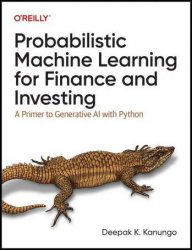 Название: Probabilistic Machine Learning for Finance and Investing: A Primer to Generative AI with Python (Final)
Название: Probabilistic Machine Learning for Finance and Investing: A Primer to Generative AI with Python (Final)Автор: Deepak Kanungo
Издательство: O’Reilly Media, Inc.
Год: 2023
Страниц: 250
Язык: английский
Формат: epub (true)
Размер: 17.4 MB
Whether based on academic theories or discovered empirically by humans and machines, all financial models are at the mercy of modeling errors that can be mitigated but not eliminated. Probabilistic ML technologies are based on a simple and intuitive definition of probability and the rigorous calculus of probability theory.
Unlike conventional AI systems, probabilistic Machine Learning (ML) systems treat errors and uncertainties as features, not bugs. They quantify uncertainty generated from inexact model inputs and outputs as probability distributions, not point estimates. Most importantly, these systems are capable of forewarning us when their inferences and predictions are no longer useful in the current market environment. These ML systems provide realistic support for financial decision-making and risk management in the face of uncertainty and incomplete information.
Probabilistic ML is the next generation ML framework and technology for AI-powered financial and investing systems for many reasons. They are generative ensembles that learn continually from small and noisy financial datasets while seamlessly enabling probabilistic inference, prediction and counterfactual reasoning. By moving away from flawed statistical methodologies (and a restrictive conventional view of probability as a limiting frequency), you can embrace an intuitive view of probability as logic within an axiomatic statistical framework that comprehensively and successfully quantifies uncertainty. This book shows you why and how to make that transition.
Generative AI, and Chat GPT-4 in particular, is all the rage these days. Probabilistic machine learning (ML) is a type of generative AI that is ideally suited for finance and investing. Unlike deep neural networks, on which ChatGPT is based, probabilistic ML models are not black boxes. These models also enable you to infer causes from effects in a fairly transparent manner. This is important in heavily regulated industries, such as finance and healthcare, where you have to explain the basis of your decisions to many stakeholders.
Probabilistic ML also enables you to explicitly and systematically encode personal, empirical, and institutional knowledge into ML models to sustain your organization’s competitive advantages. What truly distinguishes probabilistic ML from its conventional counterparts is its capability of seamlessly simulating new data and counterfactual knowledge conditioned on the observed data and model assumptions on which it was trained and tested, regardless of the size of the dataset or the ordering of the data. Probabilistic models are generative models that know their limitations and honestly express their ignorance by widening the ranges of their inferences and predictions. You won’t get such quantified doubts from ChatGPT’s confident hallucinations, more commonly known as fibs and lies.
All ML models are built on the assumption that patterns discovered in training or in-sample data will persist in testing or out-of-sample data. However, when nonprobabilistic ML models encounter patterns in data that they have never been trained or tested on, they make egregious inferences and predictions because of the inherent foundational flaws of their statistical models. Furthermore, these ML models do it with complete confidence and without warning decision makers of their uncertainties.
Google recently introduced TensorFlow Probability to extend its established TensorFlow platform. Similarly, Facebook and Uber have introduced Pyro to extend their PyTorch platforms. Currently, the most popular open source probabilistic ML technologies are PyMC and Stan. PyMC is written in Python, and Stan is written in C++. This book uses the extensive ecosystem of user-friendly Python libraries.
Who Should Read This Book?
The primary audience of this book is the thinking practitioner in the finance and investing discipline. A thinking practitioner is someone who doesn’t merely want to follow instructions from a manual or cookbook. They want to understand the underlying concepts for why they must adopt a process, model, or technology. Generally, they are intellectually curious and enjoy learning for its own sake. At the same time, they are not looking for onerous mathematical proofs or tedious academic tomes. I have provided many scholarly references in each chapter for readers who are looking for the mathematical and technical details underlying the concepts and reasoning presented in this book.
A thinking practitioner could be an individual investor, analyst, developer, manager, project manager, data scientist, researcher, portfolio manager, or quantitative trader. These thinking practitioners understand that they need to learn new concepts and technologies continually to advance their careers and businesses. A practical depth of understanding gives them the confidence to apply what they learn to develop creative solutions for their unique challenges. It also gives them a framework to explore and learn related technologies and concepts more easily.
In this book, I am assuming that readers have a basic familiarity with finance, statistics, Machine Learning, and Python. I am not assuming that they have read any particular book or mastered any particular skill. I am only assuming that they have a willingness to learn, especially when ChatGPT, Bard, and Bing AI can easily explain any code or formula in this book.
Скачать Probabilistic Machine Learning for Finance and Investing: A Primer to Generative AI with Python